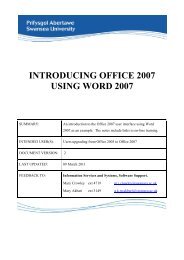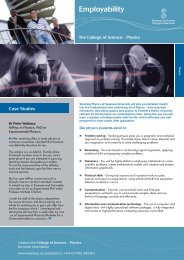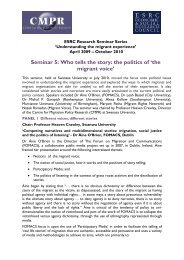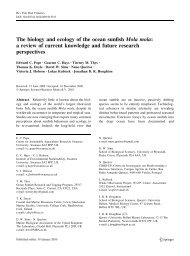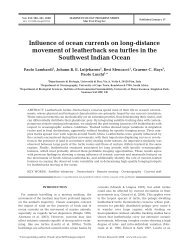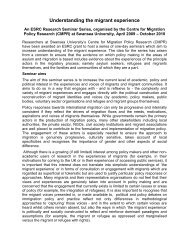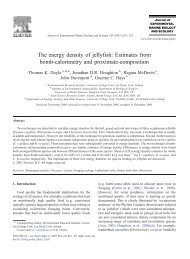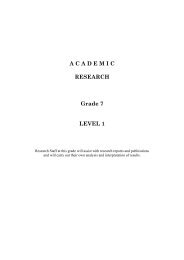Nesting of green turtles (Chelonia mydas) at ... - Seaturtle.org
Nesting of green turtles (Chelonia mydas) at ... - Seaturtle.org
Nesting of green turtles (Chelonia mydas) at ... - Seaturtle.org
Create successful ePaper yourself
Turn your PDF publications into a flip-book with our unique Google optimized e-Paper software.
B.J. Godley et al. / Biological Conserv<strong>at</strong>ion 97 (2001) 151±158 153<br />
negligible nesting activity and being logistically dicult<br />
to survey (beach nos. 13, 18, 19, 20 and 32; Fig. 1). In<br />
addition, although surveyed throughout the season,<br />
beaches 16 and 22 were subsequently deleted from analysis<br />
after having had no clutches deposited throughout<br />
the entire survey period.<br />
2.3. Calcul<strong>at</strong>ion <strong>of</strong> adult nesting success<br />
Turtles do not lay eggs during every nesting activity<br />
and can abort nesting e€orts <strong>at</strong> a number <strong>of</strong> di€erent<br />
stages <strong>of</strong> the nesting process, returning to the sea,<br />
usually to emerge l<strong>at</strong>er on the same or subsequent night.<br />
Experienced observers can assess with a high degree <strong>of</strong><br />
con®dence whether or not an activity has resulted in the<br />
laying <strong>of</strong> a clutch, i.e. ``a nest'' (cf. Bjorndal et al., 1999).<br />
This is comparable with the technique used previously<br />
on Ascension Island (Mortimer and Carr, 1987).<br />
All beaches were visited throughout the season as an<br />
integral part <strong>of</strong> track counting to enumer<strong>at</strong>e ``adult<br />
nesting success'' i.e. the proportion <strong>of</strong> activities which<br />
resulted in a nest. For consistency, this was always carried<br />
out by the authors (BJG and ACB) who were<br />
experienced in this technique (Broderick and Godley,<br />
1996). On a given survey d<strong>at</strong>e, a portion <strong>of</strong> the activities<br />
was assessed. On beaches with low levels <strong>of</strong> nesting this<br />
was all the activities, whereas on those with high levels<br />
<strong>of</strong> nesting a sample <strong>of</strong> 10±20 activities were assessed.<br />
2.4. Calcul<strong>at</strong>ion <strong>of</strong> number <strong>of</strong> clutches laid<br />
For each beach, the number <strong>of</strong> clutches laid on each<br />
day was calcul<strong>at</strong>ed by multiplying the interpol<strong>at</strong>ed or<br />
measured number <strong>of</strong> nesting activities for th<strong>at</strong> day by<br />
the overall nesting success for the season for th<strong>at</strong> beach.<br />
2.5. Additional inform<strong>at</strong>ion<br />
The length <strong>of</strong> each beach was measured along the<br />
high w<strong>at</strong>er mark using a 50 m ®breglass surveying tape<br />
measure. In addition, meteorological observ<strong>at</strong>ions<br />
(daily maximum and minimum air temper<strong>at</strong>ure and<br />
rainfall) taken throughout the study were obtained from<br />
the Meteorological Oce <strong>at</strong> the Ascension Island Air-<br />
®eld. Historic meteorological air temper<strong>at</strong>ure from 1<br />
January 1985±31 December 1997 were also provided.<br />
3. Results<br />
3.1. <strong>Nesting</strong> success<br />
<strong>Nesting</strong> was recorded on 25 beaches and these were<br />
surveyed throughout the season. <strong>Nesting</strong> beaches totalled<br />
5809 m in length, with these individual beaches ranging<br />
from 45 to 965 m (Table 1). In order to produce an<br />
Table 1<br />
Length, nesting success (N success) (95% CL), number <strong>of</strong> activities<br />
(total A), number <strong>of</strong> nests (95% CL), density <strong>of</strong> activities (A/km) and<br />
density <strong>of</strong> nests (nests/km) on each <strong>of</strong> the 25 beaches which had nesting<br />
and were surveyed throughout the season<br />
Beaches<br />
Length<br />
(m)<br />
N<br />
Success<br />
Total<br />
A<br />
Nests A/km Nests/<br />
km<br />
1 530 0.33 4500 1485 8491 2802<br />
(0.29±0.38) (1305±1710)<br />
2 337 0.30 1486 446 4408 1322<br />
(0.19±0.41) (282±609)<br />
3 237 0.38 1485 564 6266 2381<br />
(0.26±0.49) (386±728)<br />
4 150 0.32 1031 330 6873 2199<br />
(0.20±0.43) (206±443)<br />
5 160 0.18 1433 258 8953 1612<br />
(0.09±0.26) (129±373)<br />
6 331 0.33 1462 482 4417 1458<br />
(0.23±0.44) (336±643)<br />
7 428 0.41 1730 709 4042 1657<br />
(0.31±0.51) (536±882)<br />
8 178 0.29 711 206 3994 1158<br />
(0.18±0.40) (128±284)<br />
9 107 0.22 308 68 2886 635<br />
(0.03±0.41) (9±126)<br />
10 78 0.13 166 21 2121 265<br />
(0.01±0.24) (2±40)<br />
11 267 0.36 222 80 830 298<br />
(0.22±0.50) (49±111)<br />
12 965 0.52 9651 5019 10001 5200<br />
(0.46±0.58) (4439±5598)<br />
14 250 0.32 1917 613 7666 2453<br />
(0.24±0.41) (147±251)<br />
15 48 0.40 269 108 5651 2260<br />
(0.15±0.65) (40±175)<br />
17 112 0.35 633 222 5652 1978<br />
(0.21±0.49) (133±310)<br />
21 155 0.38 992 377 6400 2432<br />
(0.26±0.49) (258±486)<br />
23 87 0.40 47 19 534 213<br />
(0.00±0.83) (0±39)<br />
24 478 0.42 176 74 368 155<br />
(0.14±0.70) (25±123)<br />
25 65 0.31 553 171 8547 2649<br />
(0.16±0.45) (88±249)<br />
26 50 0.29 53 15 1060 307<br />
(0.00±0.62) (0±33)<br />
27 334 0.42 3216 1351 9613 4037<br />
(0.37±0.46) (1190±1500)<br />
28 120 0.31 1172 363 9763 3026<br />
(0.21±0.41) (246±481)<br />
29 201 0.32 1986 636 9881 3161<br />
(0.27±0.38) (536±755)<br />
30 96 0.30 681 204 7061 2118<br />
(0.17±0.43) (116±293)<br />
31 45 0.38 159 60 3499 1330<br />
(0.12±0.65) (19±103)<br />
Total 5809 na a 36036 13881 na na<br />
a na, Not applicable.<br />
overall value for the number <strong>of</strong> nests in the entire season,<br />
both the number <strong>of</strong> activities and the nesting success<br />
need to be quanti®ed. For individual beaches the<br />
mean number <strong>of</strong> activities used in the assessment <strong>of</strong>



